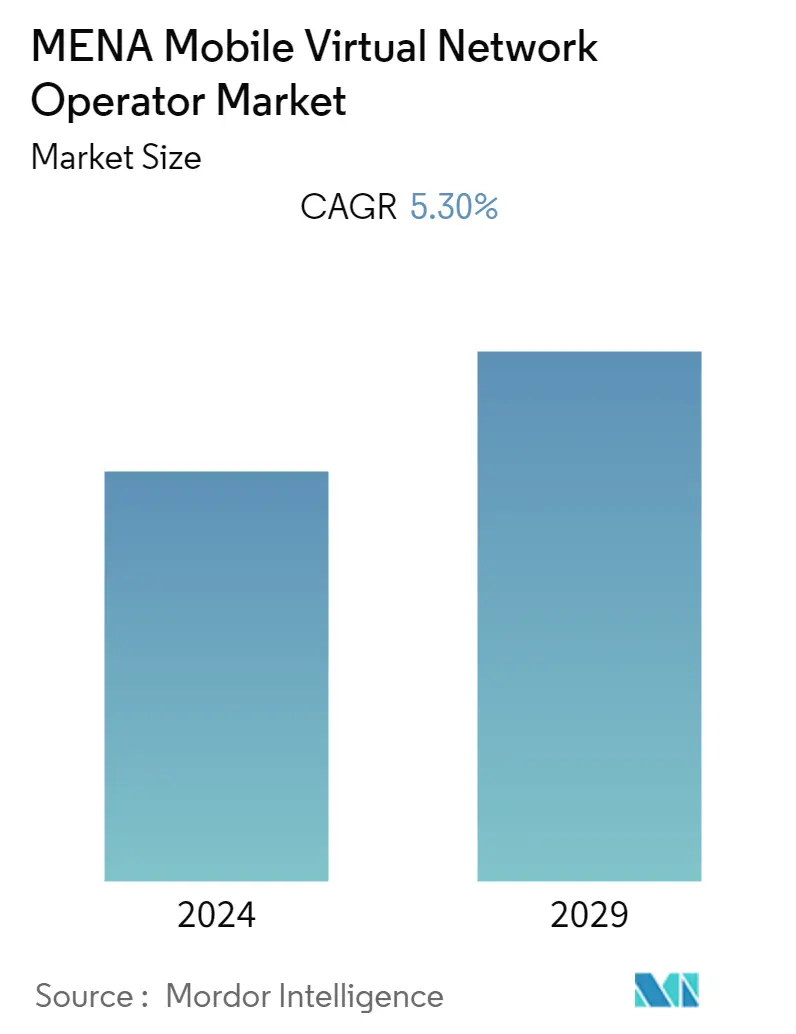Market Size of MENA Mobile Virtual Network Operator Industry

| Study Period | 2019 - 2029 |
| Base Year For Estimation | 2023 |
| Forecast Data Period | 2024 - 2029 |
| Historical Data Period | 2019 - 2022 |
| CAGR | 5.30 % |
| Market Concentration | Medium |
Major Players
*Disclaimer: Major Players sorted in no particular order |
MENA Mobile Virtual Network Operators Market Analysis
The MENA mobile virtual network operator market is expected to register at a CAGR of 5.3% during the forecasted period. Increasing penetration of mobile devices and technological advancements, such as cloud-based services and government initiatives to deliver better network service access for consumers, are driving the growth of the MENA mobile virtual network operator market.
- The growing need for communication-based services with enhanced network infrastructure primarily drives the global market for mobile virtual network operators (MVNOs). Another vital reason for spurring growth is the rising popularity of digital services, including cloud-based solutions, machine-to-machine (M2M) transactions, mobile money, etc. In addition, the introduction of novel government initiatives designed to improve consumer access to network services and advance digital services across Europe is boosting demand for MVNOs.
- Mobile virtual network operators are entering developing economies due to low competitors, increasing government initiatives, and the rising adoption rate of cloud services by business organizations. For instance, in November last year, The Communications and Information Technology Commission (CITC) of Saudi Arabia, which is in charge of policing the country's information and communication technology industry, also granted Route Mobile a "CITC License." With this development, Route Mobile will be able to serve enterprise clients and the Small and Medium Business sector in Saudi Arabia with its whole CPaaS product suite, including A2P SMS.
- Moreover, the number of telecommunications subscribers is increasing in Middle East &North African countries, which will drive the market. According to the Telecommunication Regulatory Authority, Around 1.9 million fixed-line subscriptions were active in the United Arab Emirates (UAE) as of June last year. In that month, there were approximately 3.7 million internet subscribers in the UAE.
- Additionally, the development of LTE infrastructures, which offer services like VoLTE, ViLTE, and VoWiFi, is positively impacting the world market. Throughout the forecast period, several additional factors, such as the rising popularity of embedded SIM cards and significant investments in 5G MVNO technology to provide effective communication services with low latency, are anticipated to support the global mobile virtual network operator (MVNO) market.
- Further, to ensure that all citizens and nations can fully benefit from the Internet and its economic and social potential, actions must be taken to build Internet infrastructure in a country and develop a digital economy on top of this infrastructure. The COVID-19 situation has dramatically increased awareness of these issues and, in many cases, has hastened the development of solutions. Long-term, new infrastructure can be built, which in many ways meets current needs while adjusting to new Internet uses that emerged during the crisis. Governments can start preparing for this phase by creating or modifying a national broadband plan to expand the availability of Internet infrastructure and guarantee broader digital inclusion.
MENA Mobile Virtual Network Operators Industry Segmentation
Mobile virtual network operators (MVNO) are wireless communications services provider that does not have the wireless network infrastructure over which it provides services to their customers. These companies sign a business agreement with a mobile network operator, buy bulk access to network services at wholesale rates, and set retail prices independently.
The MENA Mobile Virtual Network Operator Market is segmented by Subscriber (Business and Consumer) and Country (United Arab Emirates, Saudi Arabia, Oman, Iran, and the Rest of Middle East & North Africa). The market sizes and forecasts are provided in terms of value (USD million) for all the above segments.
| By Subscriber | |
| Business | |
| Consumer |
| By Country | |
| United Arab Emirates | |
| Saudi Arabia | |
| Oman | |
| Iran | |
| Rest of Middle East & North Africa |
MENA Mobile Virtual Network Operator Market Size Summary
The MENA mobile virtual network operator market is experiencing significant growth, driven by the increasing penetration of mobile devices and advancements in technology such as cloud-based services. Government initiatives aimed at enhancing network service access and the rising demand for communication-based services with improved infrastructure are key factors propelling the market. The popularity of digital services, including machine-to-machine transactions and mobile money, further fuels this growth. The entry of mobile virtual network operators into developing economies, supported by favorable government policies and the adoption of cloud services, is expanding market opportunities. The development of LTE infrastructures and the anticipated rise in 5G subscriptions are expected to enhance communication services and open new revenue streams for operators in the region.
The market is characterized by a concentration of major players like Virgin Mobile KSA, Lebara Mobile KSA, and others, who dominate the landscape through strategic collaborations and expansions. However, technological advancements and product innovations are enabling mid-size to smaller companies to increase their market presence. The COVID-19 pandemic has accelerated the demand for flexible communication services, while the digital transformation trend is driving the adoption of IoT and M2M technologies. As governments and businesses invest in digital infrastructure, the MVNO market is poised for further growth, with opportunities in emerging technologies such as blockchain, 5G, and artificial intelligence. The focus on improving customer service and reducing costs is encouraging the adoption of these technologies, thereby boosting market expansion.
MENA Mobile Virtual Network Operator Market Size - Table of Contents
-
1. MARKET DYNAMICS
-
1.1 Market Overview
-
1.2 Porter Five Forces
-
1.2.1 Threat of New Entrants
-
1.2.2 Bargaining Power of Buyers/Consumers
-
1.2.3 Bargaining Power of Suppliers
-
1.2.4 Threat of Substitute Products
-
1.2.5 Intensity of Competitive Rivalry
-
-
1.3 Industry Value Chain Analysis
-
1.4 Impact of COVID-19 on the MVNO Market
-
-
2. MARKET DYNAMICS
-
2.1 Market Drivers
-
2.1.1 Government Strategy to Enhance Business Environment, and Foster the Adoption of International Best Practices Across Industry
-
2.1.2 Significant Growth Opportunities for Mobile Subscriptions in Largely Populated Countries
-
2.1.3 Deployment of 5G technology to drive the market
-
-
2.2 Market Challenges
-
2.2.1 Issue Regarding Infrastructure Destruction, Humanitarian Crises, and Security Concerns in Middle East Countries
-
-
-
3. MARKET SEGMENTATION
-
3.1 By Subscriber
-
3.1.1 Business
-
3.1.2 Consumer
-
-
3.2 By Country
-
3.2.1 United Arab Emirates
-
3.2.2 Saudi Arabia
-
3.2.3 Oman
-
3.2.4 Iran
-
3.2.5 Rest of Middle East & North Africa
-
-
MENA Mobile Virtual Network Operator Market Size FAQs
What is the current MENA Mobile Virtual Network Operator Market size?
The MENA Mobile Virtual Network Operator Market is projected to register a CAGR of 5.30% during the forecast period (2024-2029)
Who are the key players in MENA Mobile Virtual Network Operator Market?
Lebara Mobile KSA, Virgin Mobile KSA, Swyp (Etisalat UAE), Majan Telecommunication LLC (Renna Mobile) and FRiENDi mobile are the major companies operating in the MENA Mobile Virtual Network Operator Market.

